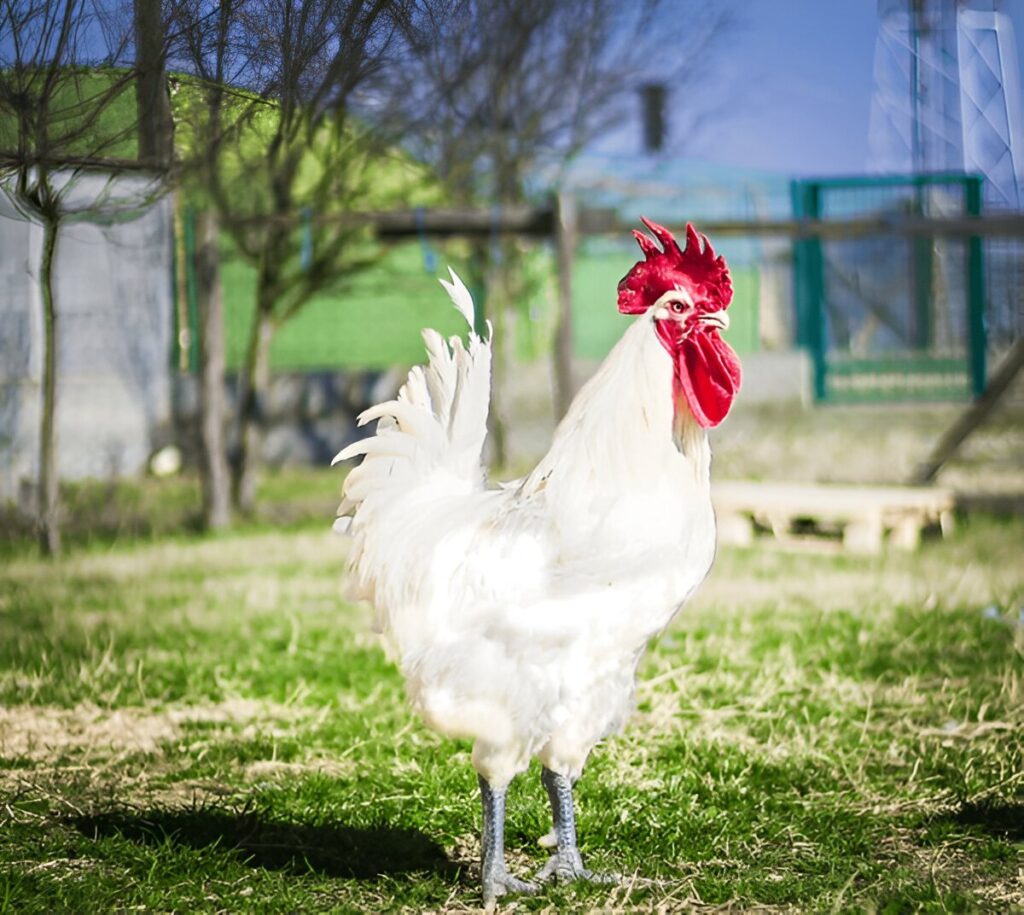
If you’ve ever dined at a Michelin-starred restaurant, you might have encountered Bresse chicken—a breed so revered it’s dubbed the “queen of poultry” and protected by France’s prestigious AOC certification (like Champagne!).
With its melt-in-your-mouth texture and rich flavor, the Bresse is the gold standard for gourmet chicken.
But what makes this breed so special, and can you raise it outside France? In this guide, we’ll explore the history, care, and culinary magic of Bresse chickens.
What Is a Bresse Chicken?
The Bresse chicken (Poulet de Bresse) is a heritage breed from the Bresse region of eastern France.
Known for its striking appearance—white feathers, blue legs, and a bright red comb—it mirrors the French flag, earning it the nickname “le tricolore.” These birds are dual-purpose but primarily raised for their exceptionally tender, flavorful meat.
Key Traits
- Weight: Roosters: 6.6–8.8 lbs; Hens: 5.5–6.6 lbs.
- Egg Production: 180–220 creamy-white eggs/year.
- Lifespan: 5–8 years (if not harvested for meat).
AOC Certification:
Only chickens raised in the Bresse region under strict guidelines (free-range grazing, corn-and-dairy diet, minimum 4-month growth) can bear the Poulet de Bresse label.
The History of Bresse Chickens
Dating back to the 16th century, Bresse chickens were first mentioned in historical texts as a favorite of French royalty.
Their modern reputation took shape in 1957 when they became the first poultry to receive AOC status. Today, fewer than 1.5 million Bresse chickens are produced annually, with 80% consumed in France.
Fun Fact:
A single Bresse chicken can sell for over $100 in high-end markets, and whole birds are often gifted in France as a luxury present!

Why Raise Bresse Chickens?
1. Unmatched Meat Quality
Bresse meat is famed for its fine texture, juicy marbling, and delicate flavor. Chefs like Gordon Ramsay and Alain Ducasse praise its “clean, buttery taste” that outshines industrial breeds.
2. Dual-Purpose Versatility
While prized for meat, hens are reliable layers. Their eggs have rich, golden yolks perfect for baking.
3. Elegant Appearance
Their glossy white plumage, slate-blue legs, and vibrant red combs make them a stunning addition to any flock.
4. Hardy and Active
Bresse chickens thrive in free-range systems, foraging aggressively for insects and grasses.
Challenges of Raising Bresse Chickens
1. Strict AOC Requirements (If Seeking Certification)
- Must be raised in the Bresse region (departments of Ain, Jura, Saône-et-Loire).
- Fed a diet of at least 50% corn, supplemented with dairy products like whey.
- Minimum 10 sq meters of pasture per bird.
2. Slow Growth
They take 4–5 months to mature—double the time of Cornish Cross broilers.
3. Limited Availability
Purebred Bresse chicks are rare and expensive outside France (15–15–30 per chick).
4. Climate Sensitivity
While hardy, they prefer mild climates and struggle in extreme heat.
How to Raise Bresse Chickens (Even Outside France)
1. Sourcing Chicks
- Reputable Hatcheries:
- Greenfire Farms (U.S.) occasionally stocks Bresse chicks.
- Bresse-Gauloise.com (Europe) ships hatching eggs.
- Verify Lineage: Ensure breeders provide AOC lineage documentation.
2. Diet for Optimal Flavor
- Weeks 1–8: High-protein starter feed (20%).
- Weeks 9–16: Transition to a corn-based diet (50% cracked corn, 30% wheat, 20% alfalfa).
- Supplement: Dairy products like yogurt or whey 2–3x weekly for authentic marbling.
Pro Tip:
Add garlic or oregano to feed for natural parasite control.
3. Housing & Free-Range Requirements
- Coop Space: 3–4 sq ft per bird.
- Pasture: Mimic AOC standards with 10+ sq meters per bird. Rotate grazing areas to prevent overgrazing.
- Predator Protection: Use electric fencing to guard against foxes and hawks.
4. Health Management
- Leg Health: Avoid obesity with controlled feeding; Bresse chickens are prone to joint stress.
- Parasites: Conduct monthly fecal exams due to their free-range lifestyle.
- Winter Care: Provide windbreaks and dry bedding to prevent frostbite on combs.
Bresse vs. Other Gourmet Breeds
| Breed | Meat Quality | Growth Time | Diet Complexity | Unique Trait |
|---|---|---|---|---|
| Bresse | Exceptional, buttery | 4–5 months | High (corn/dairy) | AOC certification |
| Poulet Rouge | Rich, robust | 3–4 months | Moderate | Red feathers, heritage |
| Kosher King | Lean, firm | 3 months | Low | Certified kosher |
| Silkie | Velvety, mild | 5–6 months | Low | Black skin, ornamental |
Key Takeaway:
Bresse chickens require more effort but deliver unmatched gourmet quality. Poulet Rouge is a close alternative for non-purists.
Ethical & Culinary Considerations
Why Chefs Swear By Bresse Chickens
- Fat Distribution: Intramuscular fat (marbling) keeps meat moist during high-heat cooking.
- Diet-Driven Flavor: Corn and dairy create a sweet, nutty profile.
Ethical Notes
- Free-Range Necessity: Confinement stresses Bresse chickens, impacting meat quality.
- Harvest Timing: Process at 16–20 weeks for optimal tenderness.
FAQs About Bresse Chickens
Q: Can I raise Bresse chickens in the U.S.?
A: Yes, but they won’t have AOC certification. Source chicks from specialized hatcheries.
Q: Are Bresse chickens good layers?
A: Hens lay 3–4 eggs/week, but they’re primarily raised for meat.
Q: How do they compare to organic store-bought chicken?
A: Bresse meat has finer texture and richer flavor due to diet and genetics.
Q: Why are their legs blue?
A: A genetic trait tied to their heritage. It’s a hallmark of the breed.
Q: Can I show Bresse chickens in poultry competitions?
A: Yes, but ensure they meet breed standards (weight, comb shape, leg color).
Q: Do they go broody?
A: Occasionally. Hens make attentive mothers if allowed to hatch eggs.
Q: What’s the best way to cook Bresse chicken?
A: Roast whole with herbs or coq au vin to highlight its flavor.
Q: Are they noisy?
A: Hens are quiet; roosters crow moderately.
Ready to Elevate Your Flock?
For help sourcing or raising Bresse chickens, contact Chickiq.com’s poultry experts. We’ll guide you in raising this gourmet gem!
